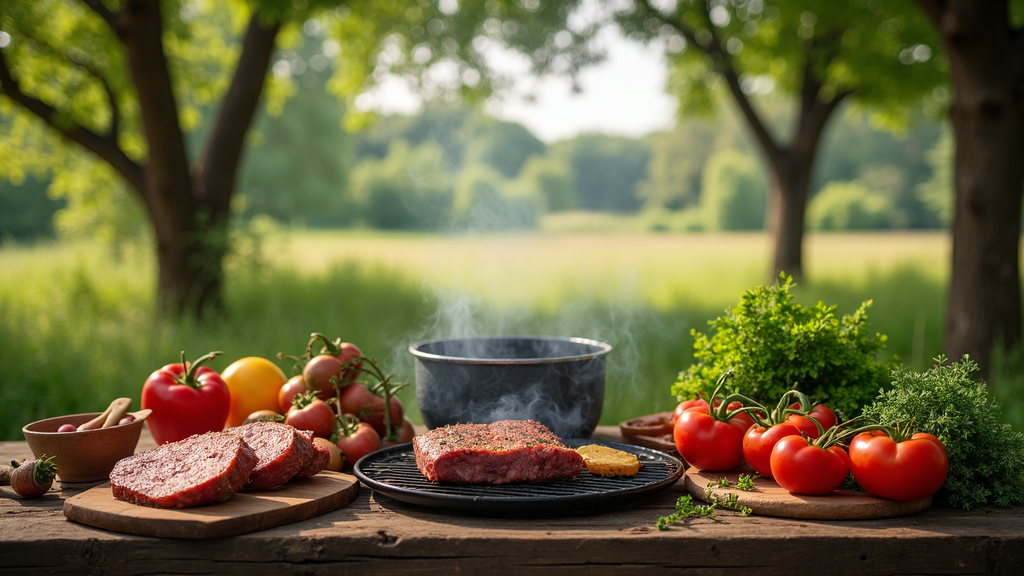The farm to fork movement has really gathered a lot of steam lately, especially among people who care deeply about where their food is sourced and how it’s cooked. From my perspective, watching this trend catch fire is pretty exciting. There’s a unique satisfaction in knowing your steak came from grassfed beef at a local ranch or that your veggies were plucked that very morning from a nearby field. When you finish those ingredients with smoking or grilling, you boost the flavor while sticking to the farmfresh mindset and letting real ingredients shine.

The Connection Between Farm to Fork and Live Fire Cooking
Smoking and grilling go hand in hand with the farm to fork philosophy. It’s about way more than just buying local; it means seeing where your food comes from, choosing the freshest picks, and giving each ingredient the respect it deserves from field to plate. Firebased cooking like grilling and smoking lets you keep it simple. There’s no need to cover up the true taste of in season ingredients—use just enough smoke or char to make them stand out. These timeless cooking styles can really make a local pork chop or homegrown tomato sing.
You’ll often stumble upon these methods at farmers markets, block parties, or just casual backyard gatherings. There’s something special about the difference between food grilled over wood coals and something tossed in a skillet indoors. That distinct, smoky character tells you the ingredients haven’t traveled far. You also know the cook put hands on every step of the meal.
How Smoking and Grilling Let Local Ingredients Shine
What excites me most about livefire cooking is that these techniques really let the quality of the food speak for itself. With a local steak, a rack of ribs, or a bunch of farmfresh veggies, a little bit of smoke brings depth without need for loads of sauce or spices. Check out how brightly produce shines when it gets that touch of fire.
- Vegetable Perfection: Grilling adds a sweet, caramelized twist to the best picks from the market.
- Simple Marinades: A salt and pepper rub does wonders for grassfed beef or free range chicken, especially when kissed by wood smoke.
- Smoke as a Flavor: Rotating different woods, like apple or hickory, helps match the flavor to whatever’s freshest.
This lowfuss cooking pairs perfectly with farm to fork’s focus on minimal processing. No flaws to hide means you don’t need loads of salt, sugar, or fillers. The food stays fresher and healthier, too.
Tips for Jumpstarting Farm to Fork Smoking and Grilling
Getting the most flavor from local foods with fire doesn’t require much—just a little planning and patience. Here’s what I’ve learned along my own ride:
- Source Fresh, Local Ingredients: Visit your farmers market, chat with area growers, or check out CSAs for the cream of the crop.
- Match Your Cooking Method: Fast cooking foods like shrimp or asparagus do best on a hot grill. Tougher cuts like brisket benefit from slow smoking.
- Try Different Woods: Jump into mixing woods like cherry or apple for mildness, or use hickory for richer meats.
- Keep Seasoning Simple: Let your main ingredients do the talking. Olive oil, salt, fresh herbs, and maybe a dash of vinegar can step up just about anything.
- Cook Over Coals: Charcoal or real wood brings out deeper, richer flavors than propane. I always say, if you can grab lump charcoal, go for it.
It takes a little practice to get it right. But the moment you bite into a justharvested tomato or freshly cut corn off the grill, you’ll know the extra attention pays off. Nothing else delivers quite the same flavor.
Things to Keep in Mind Before Firing Up the Grill
At first glance, livefire cooking seems simple, but it presents a few real challenges if you want to stick closely to the farm to fork spirit. Check out these tips:
- Source Quality: Not all “fresh” foods are created equal. Look for meat and produce grown sustainably or raised nearby rather than shipped from far away.
- Seasonal Availability: Your menu might need to mix things up based on what’s currently ready to harvest. Peak summer means endless veggies, while autumn brings new flavors to the table.
- Equipment Learning Curve: Getting comfortable with fire, a smoker, or a basic kettle grill takes a bit of effort. But there are tons of tutorials out there to help you along.
- Temperature Control: Maintaining just the right heat using wood or charcoal requires a watchful eye. Expect a little trial and error as you get a feel for your tools.
- Food Safety: It’s extra important to stay sharp about cleanliness, cooking temps, and handling farm sourced meats or eggs.
Choosing the Right Equipment
You don’t need a tricked out smoker to cook well with fire. My own start was with a used Weber kettle. A simple smoker or even a homemade smoke box for a standard grill does the job if you want to experiment. Over time, you might invest in an offset smoker or ceramic cooker as your skill and curiosity grow.
Cooking With the Seasons
The market’s best offerings change throughout the year. Sometimes it’s tomatoes and zucchini; other times, apples and root vegetables take the spotlight. Enjoy the ride of discovering new favorites as the eating seasons come and go.
Building Trust and Traceability
Being true to farm to fork means caring about how your food is raised and grown. Don’t be shy to ask your farmer or producer for growing details or prep tips—they’re proud to share and want you to enjoy the results. Forming those partnerships deepens your connection to every meal.
No hiccup should make you shy from giving livefire cooking a try. A willingness to learn as you go pays off, and each attempt will only taste better.
How Smoking and Grilling Bring People Together
One of the best things about grilling and smoking with farmfresh ingredients is the sense of community it sparks. Good food outdoors, shared with friends or neighbors, is simply unbeatable. Whether at backyard BBQs, pop up farm dinners, or summer potlucks, there’s something special about smoke drifting in the air while everyone gathers around. It also gives producers and farmers a chance to showcase their best in a relaxed, festive setting.
Local restaurants are joining the movement too. Chefs join forces with area farms, grab fresh meats and veggies, and then give them some time on the grill or in the smoker. It’s a winwin—producers get their goods in front of diners, and customers get unforgettable and new dishes to talk about.
Questions People Have About Farm to Fork Smoking and Grilling
Here are a few questions I hear most often from people curious about mixing livefire cooking with local food:
Question: What types of wood are best for different meats and veggies?
Answer: For lighter meats or produce, fruitwoods like apple and cherry are awesome. For heartier cuts like beef or lamb, woods like oak and hickory add more punch. Stay away from pine—it can taste odd and be too harsh.
Question: Do I need fancy equipment to get great barbecue?
Answer: Not at all. A regular grill, some good charcoal, and even a foil packet of wood chips will set you up just fine. You can always add bigger smokers or other gear later after you’ve honed your style.
Question: How do I know ingredients are truly local?
Answer: A lot of vendors label their products at the market. Don’t hesitate to check in and ask! Most farm to fork producers love sharing their process, and many can offer cooking hints as a bonus.
Quick Moves to Take Up Your Farm to Fork Live Fire Cooking
If you’re ready to take things up a notch, here are a few quick tips I rely on for even better flavors and a more eye catching plate:
Brine or Marinate: Even a simple saltwater soak or light marinade keeps meat juicy and deepens flavor.
Try Reverse Sear: Slow cook thick cuts first, then give them a final high heat blast on the grill for that perfect crust without overcooking.
Smoke Roasted Veggies: Toss whatever’s freshest with a little olive oil and sizzle in a cast iron skillet over the coals. The result is regular roasted vegetables with a nextlevel cool smoky facelift.
Rest and Slice Properly: Give grilled meat a breather before cutting so juices stay locked in. Slice across the grain for max tenderness, especially on leaner grassfed options.
Mix in Salsas and Fresh Toppers: Grilled food pairs perfectly with justmade salsas, chopped herbs, or local greens, which adds both flavor and nutrition.
Local Examples in Action
I’ve witnessed some truly eye catching farm to fork moments: a farmer’s market chef cooking vegetables over open flames, a hog roast with heritage pork raised you could meet, or a picnic where grilled local peaches left everyone speechless. It doesn’t require fancy gear—just fresh ingredients and a willingness to play with live fire.
- Farmers Market BBQ: Local festivals often feature BBQ contests using alllocal meats and veggies, offering a peek into the region’s unique flavors.
- Restaurant Collaborations: Chefs who source locally almost always roll out smoked or grilled specials during peak season.
- Homegrown Cookouts: A couple of backyard grown herbs or garden tomatoes tossed on your trusty grill can link you to the land and taste out of this world.
Wrapping Up
Pairing the farm to fork idea with livefire grilling and smoking brings out the best of both: unmasked flavor, wholesome eating, and stronger bonds between people. Whether it’s a lazy Sunday with friends or a weeknight meal that started with a basket of just picked produce, you’ll find live fire makes the whole field to table adventure even more satisfying.
Grab some local wood, grab the freshest ingredients you can find, and light that grill. There are plenty of good meals—and good moments—waiting ahead.
